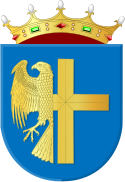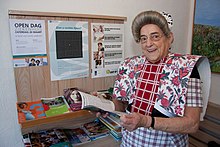Buns
 flag |
 coat of arms |
| province |
|
| mayor | Melis van de Groep ( CU ) |
| Seat of the municipality | Bunschoten-Spakenburg |
|
Area - land - water |
34.88 km 2 30.50 km 2 4.38 km 2 |
| CBS code | 0313 |
| Residents | 21,607 (Jan 31, 2019) |
| Population density | 619 inhabitants / km 2 |
| Coordinates | 52 ° 15 ′ N , 5 ° 22 ′ E |
| Important traffic route |
|
| prefix | 033 |
| Postcodes | 3751-3754 |
| Website | Homepage of Bunschoten |
Bunschoten ( ) is a municipality in the Netherlands , province of Utrecht . It has 21,607 inhabitants (as of January 31, 2019). Their total area is about 35 km². It consists of the elongated twin village of Bunschoten-Spakenburg (Spakenburg is the northern part, with the fishing port on the Eemmeer), and the small farming village of Eemdijk on the Eem River, which can be reached by ferry.
Location and economy
Bunschoten is located in the northeast of the province, just a few kilometers north of Amersfoort . In the east it borders on Nijkerk ( Gelderland province ). Bunschoten lies in the somewhat swampy, slightly below sea level lying polders around the river Eem, which flows from Amersfoort to Eemmeer. The Eemmeer is a marginal lake of the IJsselmeer, which is largely diked here (see Flevoland province ).
Bunschoten used to make a living from cattle farming (which is still partly the case), and Spakenburg was a fishing village. Fishermen and fish processing companies still exist, but Spakenburg is now better known for its bread factories . This bread is mainly sold in markets all over the Netherlands. There are also a few larger factories that manufacture all kinds of metal goods. Tourism is also gaining in importance.
History and national character
Bunschoten received a limited town charter in 1383, but was soon destroyed due to an uprising against the sovereign, the bishop of Utrecht , and continued to develop as a village.
Spakenburg is an old fishing village. Since the fisherman has a dangerous job, which is strongly determined by the perils of nature, more than in other professions people pray to God for luck and the absence of disasters. Spakenburg is also a strongly religious community in which the house is only left to go to church on Sundays. Quite a few people belong to the more conservative, Orthodox- Calvinist churches. Another aspect of this conservatism is that the old costumes are still worn, especially when attending church services and at festivals.
Soccer
Spakenburg is home to two leading teams in the top Dutch amateur class ( top class ), SV Spakenburg and VV IJsselmeervogels . With seven amateur championships, the IJsselmeervogels are the most successful club in Dutch amateur football.
Attractions
- The Vurhuus Costume Museum (open from Easter to the end of October, closed on Sundays)
- The Spakenburg harbor, with many old sailing ships that used to be used for fishing. A self-closing flood protection wall was installed here in 2017 . Usually sunk in the quay, at high tide it is lifted from the ground by the water pressure.
- The Spakenburg Festival in summer, as well as the fishing day in autumn, when the women wear their old costumes, attract many tourists.
Web links
- Website of the municipality (Dutch)
Individual evidence
- ↑ Bevolkingsontwikkeling; regio per maand . In: StatLine . Centraal Bureau voor de Statistiek (Dutch)
- ↑ Wereldprimeur: 'opdrijvende waterkering' beschermt voortaan Spakenburg - NOS. In: nos.nl. Retrieved November 8, 2017 .


